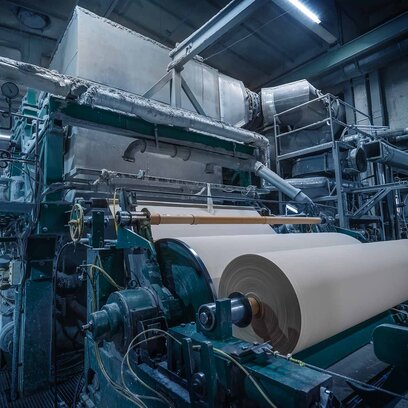Key Benefits of GCC in Paper & Packaging
-
Enhanced whiteness: Boosts print clarity and visual appeal.
-
Higher light scattering: Improves opacity, reducing ink penetration.
-
1 μm, 2 μm for premium coated papers.
-
Increased paper stiffness: Improves durability in packaging.
-
Higher bulk with lower basis weight: Reduces paper weight while maintaining performance.
-
3 μm and 5 μm (for packaging boards and lightweight paper applications).
-
TiO₂ & Kaolin Alternative: GCC acts as a functional extender, reducing the need for expensive white pigments such as titanium dioxide (TiO₂) and fillers such as kaolin. TiO₂ is widely used for opacity and brightness in paper, but is significantly more expensive. GCC, particularly in 2 μm, 3 μm and 5 μm grades, offers a cost-effective way to achieve similar optical properties at a lower formulation cost. Compared to kaolin, GCC offers better light scattering properties, allowing manufacturers to maintain the required brightness and opacity at a lower overall material cost.
-
Lower production costs: By increasing the GCC content in formulations, papermakers can reduce their reliance on more expensive raw materials without compromising the quality of the final product. GCC contributes to improved bulk and surface smoothness, which helps optimise the papermaking process by reducing the amount of expensive fibre content required. In addition, its excellent dispersion and compatibility with paper coatings allow higher loading levels, minimising production costs while maintaining printability, strength and durability.
-
2 μm, 3 μm, 5 μm for cost-effective formulations.
-
Better ink absorption: Enhances ink adhesion and color vibrancy.
-
Reduced paper dusting: Improves print quality in high-speed presses.
-
1 μm, 2 μm for high-quality printing papers.
-
Eco-friendly filler: Supports sustainable paper production.
-
Reduced carbon footprint: Natural alternative to synthetic fillers.
-
All Grades 1–10 μm, especially fine-particle GCC for sustainability-focused applications.
Applications of GCC in Paper & Packaging
-
Enhanced print definition: Improves brightness and ink holdout.
-
Smooth surface for quality printing: Reduces defects in offset and digital printing.
-
1 μm, 2 μm for premium printing papers.
-
Improved stiffness & bulk: Provides structure to cartons and corrugated boards.
-
Enhanced strength with lightweighting: Reduces raw material usage while maintaining rigidity.
-
3 μm, 5 μm for food and consumer packaging.
-
Soft texture enhancement: Provides smoothness in tissue products.
-
Increased bulk with reduced weight: Ideal for lightweight, high-strength applications.
-
2 μm, 3 μm for softness and absorbency improvements.
Cemix provides high-purity GCC grades tailored for paper & packaging applications. Our optimized particle size distribution, high brightness, and excellent dispersion properties ensure cost-effective, high-performance solutions.
By incorporating Cemix GCC, manufacturers benefit from enhanced printability, bulk efficiency, and sustainability advantages.
Contact us today for customized solutions in paper & packaging applications.
Ground Calcium Carbonate (GCC) plays a vital, cost-effective and indispensable role in the improvement of fibre-based packaging, paperboard, flexible packaging and graphic papers:
In fibre-based packaging such as cartons, folding cartons, corrugated packaging, Cemix GCC improves stiffness, printability and sustainability while optimising production costs.
- Higher bulk & stiffness: 3-5 μm GCC increases the stiffness and strength of paper-based packaging while allowing for lighter constructions.
- This helps you save raw material costs by reducing reliance on expensive fibre content.
- Improved printability: 1-2 μm GCC provides a smoother surface for printing, resulting in sharper images and better ink adhesion.
- This helps to improve oil and moisture resistance in certain coated applications.
On paperboards such as folding cartons, liquid packaging and food boxes, Cemix GCC improves strength, coating efficiency and visual appeal for high quality packaging solutions.
- Higher Opacity & Whiteness: Our GCC improves the visual appearance of packaging while ensuring colour consistency. Our 1-2 μm GCC acts as a coating pigment, providing better coating efficiency by reducing ink absorption and improving print clarity.
- Barrier Functionality: Used in coated paperboard such as food cartons, coffee-to-go cups, etc., our GCC improves resistance to grease, water and oxygen, which is critical for food packaging.
On flexible packaging & specialty papers such as labels, wrapping paper, laminates, GCC improves the flexibility, coating properties and printing performance in specialty paper applications.
- Optimised coating layers: 1-2 μm GCC helps control gloss, texture and ink holdout in label and flexible packaging applications.
- Lightweighting & Strengthening: GCC in 2-3 μm grades enable thinner materials with improved mechanical properties, reducing material consumption.
On graphic papers used for printing, magazines and high quality print media, our GCC optimises brightness, print quality and surface smoothness, making them truly premium paper products.
- High Brightness & Opacity: GCC maximises light scattering to improve paper whiteness and reduce ink transparency. GCC replaces expensive TiO₂ in premium papers, reducing overall formulation costs.
- Improved print definition: GCC reduces ink absorption, resulting in crisp, high-resolution images in magazines and fine print media.
- Smoother Surface: GCC helps create a smooth, even surface, reducing paper dusting and ink bleed in high-speed printing.
